On December 15, 2013, Sekai Project launched their first Kickstarter ever – 2013 Moe Headphones Design Doujin by Lunatic Joker. Despite the fairly niche product, a little over 500 people backed the campaign and made it a success. After that, Sekai Project turned to visual novel Kickstarters and have been doing so ever since. After seven projects that ranged from pretty successful to downright massively overfunded, it honestly seemed as though they could never fail. This company had gained the attention of English visual novel fans and it seemed they were willing to support all types of games, from romance to fantasy to sci-fi.
Then Witch Boy Magical Piece happened. At Otakon 2015, Sekai Project announced this game alongside other visual novel acquisitions. Unlike the rest, it shared that the title in particular would be coming to Kickstarter in the near future. And so it did, and as we’ve since seen, it has become Sekai Project’s first unsuccessful Kickstarter campaign. With a goal of $57,000, it managed to attain $25,189 before concluding. $25,000 is no small sum of money and many visual novel Kickstarters would go bananas in order to achieve such support. Of course, now none of that money will be filtering into Sekai Project and developer Rosemary House.
Why did Witch Boy Magical Piece fail despite its connection to Sekai Project? After all, for better or for worse, this is the company which has become the go-to name in the Western visual novel scene. There are a variety of potential reasons why this Kickstarter didn’t make it, some of which likely have a stronger bearing than others. With that said, let’s take a look at some of the biggest reasons one by one to discern exactly how this happened.
First, there’s the matter of the content of Witch Boy Magical Piece. Visual novels are a niche in and of themselves, but one that is definitely growing. It’s when you start narrowing in on niches within the genre that you really have the potential to lose large portions of the audience. I am not suggesting that a boy’s love (BL) or yaoi game cannot gain a large audience in the west. That is not only a hilariously wrong statement, but one which has been proven wrong by successful BL visual novel Kickstarters such as Coming Out On Top and Starfighter: Eclipse. Yaoi fandom in the anime and manga scene is pretty huge, which also leads to some crossover fans. The same is true of “gender bender” titles, with ones such as Gender Bender DNA Twister Extreme and Max’s Big Bust seeing themselves funded easily.
Where things get messy is the combination of both these niches. First, you take the visual novel community and weed out those not interested in (or at the very least open to) a BL game. Then, you siphon out the people within that smaller group who are actually interested in or okay with “gender swap” themes as well. Yes, there is most certainly a community of folks out there who dig both these themes and love seeing them in Witch Boy Magical Piece. I am not questioning that, especially when one of our own staff members counts herself in that group! What I am suggesting, though, is that this community is not as massive as the visual novel, or even BL-general scene, leading to a smaller pool to draw backers from.
Because of this smaller potential audience of backers, it would have made sense for Sekai Project to price the campaign close to other niche visual novels with at all similar themes. Many of the games I mentioned earlier are likely comparison points. For as much love as Coming Out On Top has received over the years, it didn’t even manage to crack $40,000 in funding in 2012. Much more recently, Max’s Big Bust achieved a little under $20,000 (converted from AUD) by the end. For most visual novels which strike out beyond the heteronormative realm on crowdfunding sites, it seems rare to set expectations over $30,000. It’s worth noting that Starfighter: Eclipse raised over $100,000 primarily because of the longstanding fan community it had built around its webcomic series. It did not just receive tons of money out of the blue — it had an audience to begin with.
That’s another issue with the Witch Boy Magical Piece campaign. Sure, Sekai Project got the word out fairly early for the campaign but prior to that it was not a particularly well known game. Despite my intense interest in the visual novel community (and lurking of various fan communities) I had totally never heard of it before. A fandom is not required to succeed on Kickstarter, but there’s no doubt that it helps. Just look at the outrageous success of the Muv-Luv Kickstarter. There’s no doubt in my mind that tons of anime fans who have never played a visual novel before backed this alongside visual novel diehards. When you don’t have a large group you “know” will back, then it’s important to price a campaign accordingly.
Despite Sekai Project’s increasingly vast knowledgebase of Kickstarter, translating, and publishing games, I feel they severely overpriced it. Again, just look at what similar campaigns managed to raise. Outside of extenuating circumstances, niche visual novels aren’t expected to raise $50,000. My belief is that Sekai Project was very aware of what it would cost to do everything they needed to prepare Witch Boy Magical Piece for Steam, and the cost of translation, porting, and all that did amount to $50,000 or more. However, the reality of Kickstarter is that people rarely arrive with accurate price points in mind. They do a very simple guestimate, end up needing more money, and then cross their fingers that it all works out.
I don’t believe that Sekai Project should view Kickstarter in such a lackadaisical way, as with dozens upon dozens of projects, they simply cannot sustain funding mismanagement in the long term. As such, I applaud them for placing the campaign at a price where they would feel comfortable putting all the work into making Witch Boy Magical Piece a reality for us. This just happens to be the point at which “smart business” does not mesh with “smart Kickstarting.” Instead of just throwing the campaign out there and ending up with a mark of failure on their record, it would have been worth second-guessing and realizing that it was incredibly unlikely this project would ever succeed at the required amount of funding.
If Sekai Project had faith in Witch Boy Magical Piece enough to bring it to Kickstarter, then they honestly should have acted like it. This was their ninth Kickstarter campaign and eighth visual novel one. With tons of skill in how to promote these types of games, the page for Witch Boy Magical Piece honestly looked like something that a first-time Kickstarter creator put together. It wasn’t a “low information” campaign by any stretch, but the information provided on the page was lacking the degree of polish that Sekai Project has showcased with other recent campaigns such as Memory’s Dogma and The Human Reignition Project.
Seriously, just take a look at those and their lovingly produced images overlaid with carefully chosen fonts, clearly displayed reward tier graphic, and 14+ updates each. Heck, even though the Witch Boy Magical Piece is bursting with images, it looks as if something I would have put together. Images shown come in all resolutions, making the page visually sloppy. This is opposed to the other recent projects which did their best to ensure almost every picture was at least the same size.
I recognize that the mobile phone origins of this game mean it probably doesn’t have super large source images, but there still should have been away around this sloppy presentation. It only got worse as Sekai Project finally updated the page with new tiers and embedded Vine videos. New reward images were simply thrown together at the bottom of the page with no real apparent care. Also, why in the heck didn’t this one get a reward tier graphic like the others? Updates also never really reached critical mass, as by the end, it had only received seven updates.
Sekai Project has the skills to make a gorgeous Kickstarter page and for whatever reason they chose not to. Or, they may just not have had the time. If you follow their Twitter then you will see that they were still deep into convention-going season at this point, with staff all over the place. In that case, why was it so imperative to launch this project right now? Presumably, there was some business contract with Rosemary House already in place stipulating it would occur mid-September. I still find that an unfair excuse, though, as smart business planning involves preparing well in advance for known busy periods.
Preparing the page could have been done mostly in advance (since Kickstarter allows for “draft” projects), leaving room to pretty up newly-received assets closer to the launch date. Well, who knows what really went on behind the scenes, but being busy in and of itself does not feel like a fair excuse to Rosemary House who put their trust in this western visual novel publisher to promote their work well. Once the Kickstarter did launch, things were disturbingly quiet on the Sekai Project press front.
Sure, they sent out an email to all those on the Sekai Project mailing list at the launch, but did not talk about the project nearly as much as it felt they have with others in the past. The news just sort of drizzled out as if they expected folks who write about video games to all simply advertise for them. To be sure, many websites did cover the Kickstarter, but that didn’t really do much to expand the niche audience. It seems that those excited for the project knew of its launch early on, backed, and then that was about it — articles did little to reach the non-interested majority. Even so, I do not feel this excuses how Sekai Project published an obviously unfinished Kickstarter and did little to self promote.
At least, this was the case when the Kickstarter needed the biggest push at the very start. Sometimes, projects with really blow their launch window can still pick up steam and succeed by the end — but it’s pretty uncommon. Strong starts facilitate eventually successful finishes, even if they’re by an incredibly small margin. It’s possible that this company felt the strength of their brand in their visual novel community alone would have been enough to sustain the campaign. After all, the Sekai Project name (as well as the high-profile projects it attracts) routinely make it so they barely have to send out one Tweet to find everything easily funded.
That was unfortunately never going to be the case with Witch Boy Magical Piece (given everything standing in the way), so more needed to be done. Sekai Project did eventually start hyping up their game, but only after weeks had already passed with the funding number increasing at a snail’s pace. The late-game changes to the Kickstarter page content and reward tiers just proves that it was launched too soon. If run again with its goal halved, it would probably succeed. The question is whether or not they are willing to approach this possibility, fund the work on their own, or simply leave the project behind. We don’t know just yet. Although Sekai Project have recently gone on a backer update spree on their various Kickstarter projects, Witch Boy Magical Piece has yet to receive an update since October 10 (but one is probably coming very shortly now that it has officially failed).
My hope is that Sekai Project does not chalk up this failure to mean that there is not an audience for BL or even gender-bending visual novels. That is absolutely not true. Both on and off Kickstarter, these genre draw a ton of attention. For example, MangaGamer’s release of No, Thank You!!! did quite well sales-wise in part because very few yaoi titles have ever been officially released for the English visual novel community. Witch Boy Magical Piece’s niche within a niche status proved the bigger issue, alongside with the campaign’s weirdly rushed nature which led to a lack of polish, press, and severely limited initial reward tiers.
Given Sekai Project’s immense knowledge of Kickstarter, I am shocked. Not shocked that they had a failed campaign, but by the fact they allowed an unprepared project to go live and somehow still expect everything to work out fine. I expect that this event proves Sekai Project’s moment of realization that they are not infallible and will henceforth put a fair level of effort into all projects, Kickstarter or otherwise.

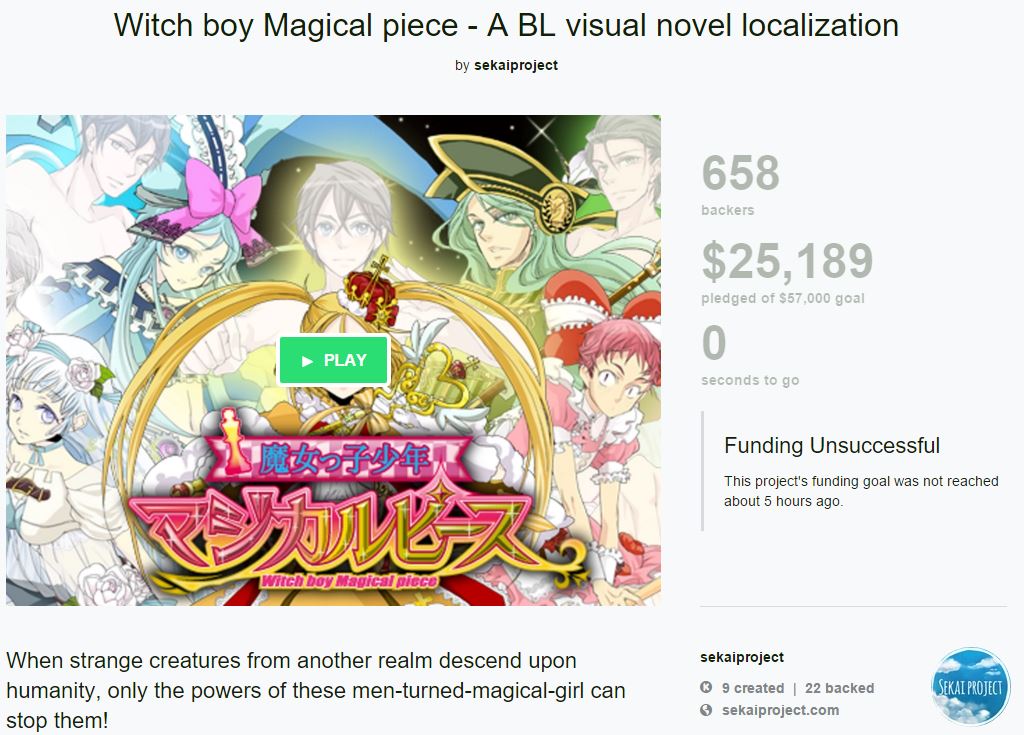
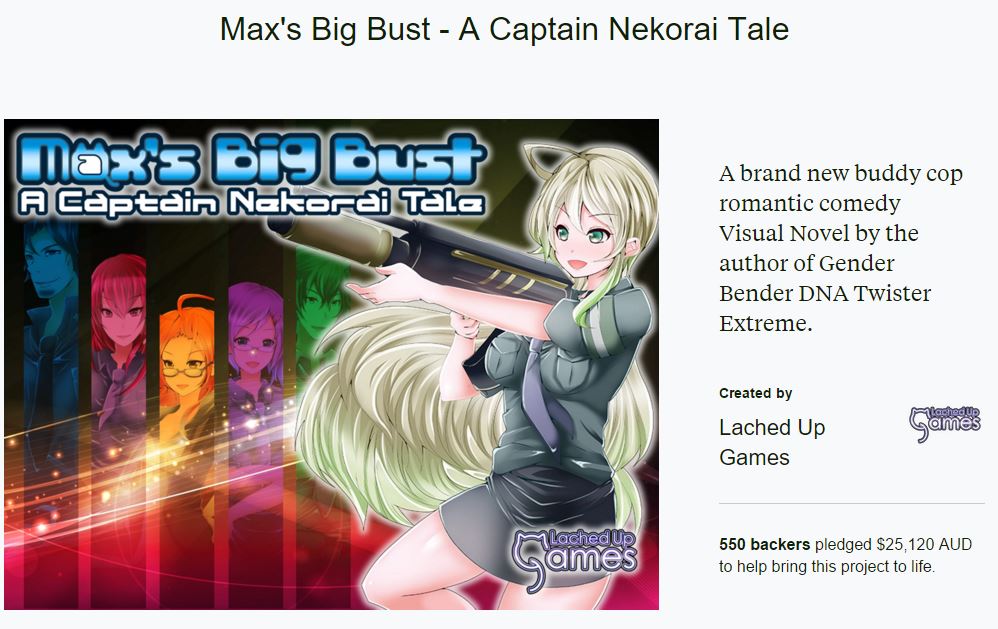
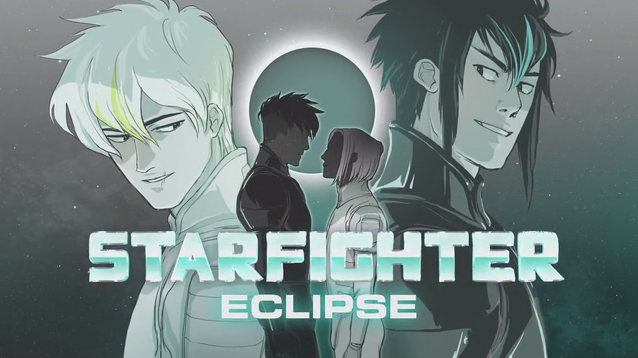

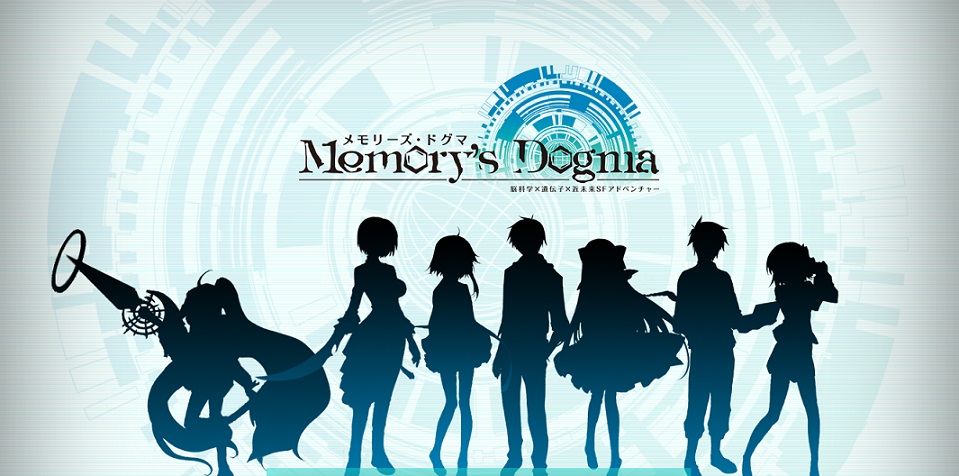


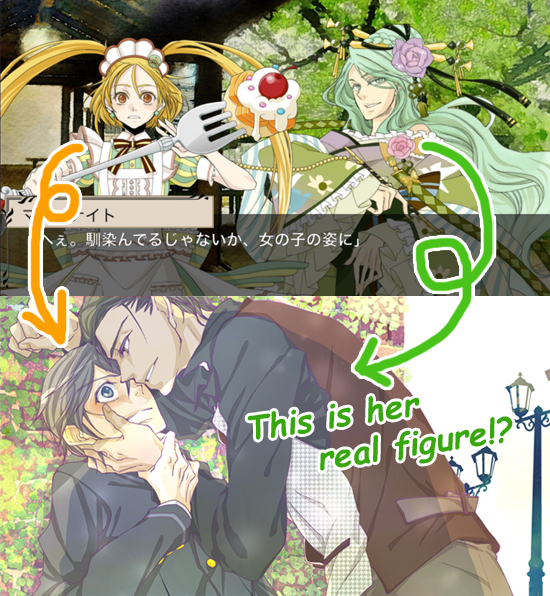



Interesting point of view that i mostly share.
But..(there is always a but :P) do you not think that Sekai Project..didn’t really care that much for this project? I see this project as an experimental project as in “let’s see if it works”. You know even if it end up in failure, they gathered some nice data (as you analyzed it). the depth of the BL/gender bender market.
Also..I think that somehow some people didn’t back them because of all their pending project.
I know that i did thought twice about it myself before jumping on this trail.
I’d like to see their pending VN list reduced and some of the VN i backed being entirely released (most are partly released).
It is certainly possible that this game was just a test for them and that they didn’t really care if it succeeded/failed. I don’t WANT that to be the case though, as it still wasted some time and effort on their part to put this together just as a “test.” More than that, though, it seems unfair to Rosemary House if that was the intent all along. Finally, I feel that Sekai Project uses their (well, previously) perfect record on Kickstarter as leverage to help gain relationships with Japanese companies so they’ve lost that by having Witch Boy fail.
Oh yes, the point of them having a lot of projects is probably a part of it too! Not only do they have many Kickstarters still in the works, but tons of other non-crowdfunded games too. Some do not require much effort from them aside from advertising, but it’s still a looooot of visual novels they’re publishing.
Honestly, if Sekai wanted to keep up their perfect record, they should not have picked a BL title to continue on. Not trying to sound biased, but a BL VN is already a smaller set than a normal VN, and this is compounded with GB and magical girls. Its as you said in the article, they are trying to find a niche within a niche. The other BL titles that passed KS should be view as exceptions, not the norm. It seems like Sekai might be getting arrogant and going too fast with too many projects, but in general I feel the honeymoon/romantic phase of seeing VNs on KS is over, and people are going to be scrutinizing their donations on KS more by now.
You bring up some good points, and I agree that the “honeymoon” phase for many consumers is over now on Kickstarter. For some of us, this occurred a while back, but others are definitely feeling it this year in particular. For visual novels especially, since there seem to be multiple arriving each and every month on Kickstarter now. It’s hard to back them all, so many folks probably just gravitate to something they know they’ll like rather than taking a chance on an unknown title or genre they’re not a fan of.
Gee, I wonder which staff member that likes both BL and gender bender VNs you’re talking about. 😛
Seriously though, here’s my take on the situation. First off, I was a backer from the moment I found out about it (big surprise there). I had backed it for the above two reasons in addition to being “magical girl” (huge fan of the genre). Anyway, you’re right in that it’s a niche of a niche. Which is indeed one of the reasons that the campaign stalled. This is also the first Sekai Project…project that I backed so I can’t comment on the comparison between the others and this one. But you’re right in that it looked rushed. Which is another strike against it not even getting halfway funded. Most of your other observations are spot on as well.
Having read through every update and comment up to my final one I will add this. Sekai is not finished with trying to get Witch Boy Magical Piece localized. They didn’t specify, yet, how they’re going to go about it but they haven’t given up. They’ll probably explain in their next update what the plan is.
Also, as Dawn mentioned there are still outstanding projects that haven’t been released yet. I fully understand the desire to wait until their backlog has diminished somewhat. It’s one of my biggest pet peeves with a certain other visual novel developer that I won’t name.
😀
Thanks for the reply. I recall seeing you jump onto the Witch Boy campaign immediately. I wish more people did! But yeah, the whole rushed look of it did not help anyone out.
I would not mind if they still keep on Witch Boy Magical Piece but need to take longer to accrue funds to make it happen. I’m not sure what other avenue they might go down to get that working, though. Curious if they would consider another KS down the line at a reduced rate.
Yup, it would be really great to see their current pending KS projects finish. Most of their episodic ones have released up to ep 2 (of 3, generally) and one other game should be launching later this year. However, they seem to be a company interested on continuously accruing new properties… I would like to believe they’re going to step back from new projects until they clear out some backlog, but thus far they’ve proven to not do business this way. Just gotta keep watching them, it seems!
I’m going to have to disagree with Dawnyaa on this one, as I don’t feel that Sekai’s pending obligations were the main factor here, in fact I would argue that the few releases they have had have only encourage confidence. I think the biggest factor is the BL community itself, like Marcus I agree that one exist, but the mistake was to assume that everyone who was aware in that community already knew about Sekai Project. From the perspective of the BL community Sekai would be considered an unknown, besides, I would argue that the Success of Managagamers “No Thank You” had more to do with it being sold by traditional means. There’s a chance that many in the BL community probably aren’t well educated on crowdfunding, and probably only saw a big risk without any assurances, let’s remember that by this point Kickstarter has developed a bit of a reputation.
You bring up an interesting counterpoint about the past projects serving as a means to encourage confidence. It may depend on the backer’s mindset whether they find many in-progress projects a positive or negative, maybe.
In some ways, I’m surprised that the Witch Boy campaign managed to achieve $25,000 in funding. That alone shows that the BL audience exists – although not to the degree that Sekai Project apparently expected to come flooding in with their $50K goal. Do you think if they ran the campaign again with a reduced goal (say $35K) that they could make it? I think they could if they fixed up all the stuff they were slacking on this time (presentation, advertising, etc).
The worst thing they could do is to lower the asking amount, lowering the initial goal will only discourage the previous backers into thinking cuts were made to put out an inferior product. Personally I think they should go the Patreon route to minimize losses, while paying for most things themselves. If they insist on sticking with the Kickstarter route, they need to do some serious research into the BL community, what blogs/podcast they listen to, and find influential people in the community that can properly explain the importance of crowdfunding projects like this. to BL fans.
I never said it was the major issue. Just pointed out that in the article it was an angle that didn’t get notified which could also be a part of the explanation for some. At least, i know that for me, it made me think about it twice before backing and that everytime i’ll see a Sekai project from now on. First thing that will come to my mind is the list of project i backed from them i am still waiting for.
It is as Marcus said, it depends on the mindset of the backer.
Me, i just don’t like people that start thing a new thing before finishing the first one they started. It makes me lose confidence on them.
I know how you feel about losing confidence as projects continue to accrue. That’s why I keep track of every Sekai Project-published game, as I want to ensure a complete list out there in case there is never a need to hold people accountable. They do actually get a lot of games out, but most of them are not their Kickstarter ones (as those Kickstarter projects so far have proven to be very large undertakings).
I brought it up since we have seen various other developers do this tactic from time to time. Since we’ve never seen Sekai Project “fail” before I do wonder as to the approach they’ll take. The Patreon idea is pretty darn smart, especially since some of the developers they’ve worked with do already have Patreon accounts.